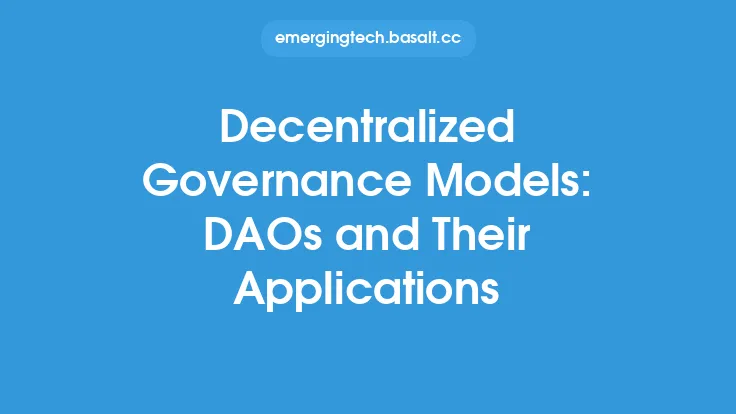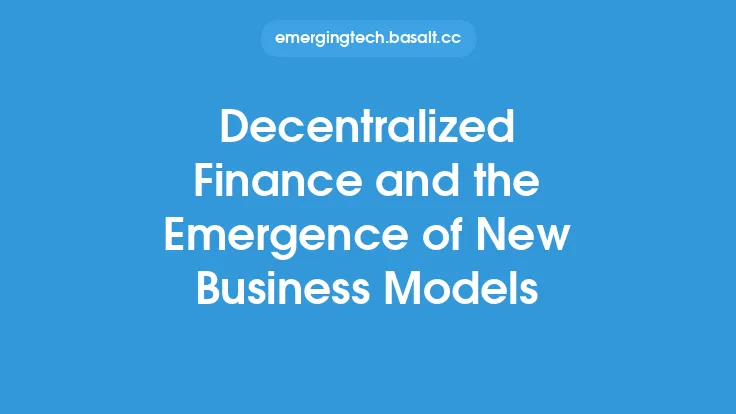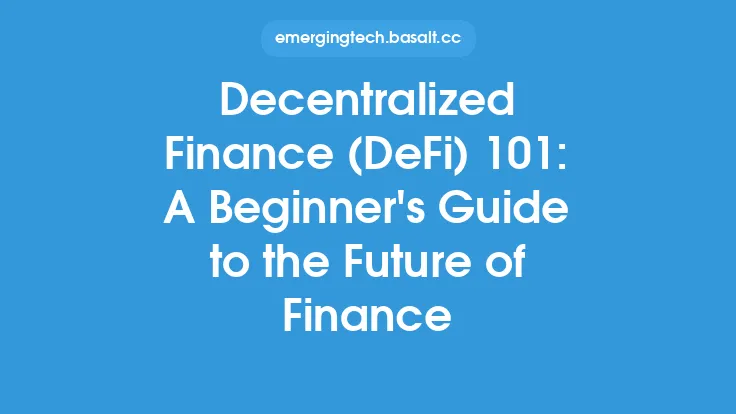Decentralized finance, commonly referred to as DeFi, has been gaining significant attention in recent years due to its potential to disrupt traditional financial systems. At the heart of DeFi are decentralized finance protocols, which are sets of rules and smart contracts that enable the creation of decentralized financial applications. These protocols are built on blockchain technology, allowing for secure, transparent, and tamper-proof transactions.
Introduction to Decentralized Finance Protocols
Decentralized finance protocols are designed to provide a wide range of financial services, including lending, borrowing, trading, and investing. They operate on a decentralized network, allowing users to interact with each other directly, without the need for intermediaries. This decentralized approach enables greater transparency, security, and accessibility, making financial services more inclusive and equitable. Decentralized finance protocols are typically built on open-source blockchain platforms, such as Ethereum, which provides a flexible and programmable infrastructure for developing and deploying DeFi applications.
Key Components of Decentralized Finance Protocols
Decentralized finance protocols consist of several key components, including smart contracts, decentralized governance, and oracles. Smart contracts are self-executing contracts with the terms of the agreement written directly into lines of code. They are used to automate various financial processes, such as lending, borrowing, and trading. Decentralized governance refers to the decision-making process used to manage and update the protocol. This can include voting mechanisms, proposal systems, and other forms of community engagement. Oracles are external data sources that provide information to the protocol, such as price feeds, which are used to determine the value of assets.
Types of Decentralized Finance Protocols
There are several types of decentralized finance protocols, each with its own unique characteristics and applications. Some of the most common types of DeFi protocols include lending protocols, decentralized exchange protocols, stablecoin protocols, and prediction market protocols. Lending protocols, such as Compound and Aave, enable users to lend and borrow assets in a decentralized manner. Decentralized exchange protocols, such as Uniswap and SushiSwap, provide a platform for users to trade assets in a trustless and permissionless environment. Stablecoin protocols, such as MakerDAO and USDC, are designed to maintain a stable value relative to a fiat currency, such as the US dollar. Prediction market protocols, such as Augur and Gnosis, enable users to create and trade prediction markets on various events and outcomes.
Applications of Decentralized Finance Protocols
Decentralized finance protocols have a wide range of applications, from financial services to gaming and social media. Some of the most significant applications of DeFi protocols include decentralized lending, decentralized trading, stablecoins, and yield farming. Decentralized lending protocols have enabled users to lend and borrow assets in a decentralized manner, providing greater accessibility and flexibility. Decentralized trading protocols have enabled users to trade assets in a trustless and permissionless environment, reducing the need for intermediaries and increasing market efficiency. Stablecoins have provided a stable store of value and medium of exchange, enabling users to hedge against market volatility and transfer value across borders. Yield farming protocols have enabled users to earn returns on their assets by providing liquidity to decentralized finance protocols.
Benefits of Decentralized Finance Protocols
Decentralized finance protocols offer several benefits, including greater transparency, security, and accessibility. They provide a trustless and permissionless environment, enabling users to interact with each other directly, without the need for intermediaries. This reduces the risk of censorship, fraud, and other forms of exploitation. Decentralized finance protocols also provide greater transparency, as all transactions and interactions are recorded on a public blockchain. This enables users to track the flow of funds and assets, reducing the risk of corruption and increasing accountability.
Challenges and Limitations of Decentralized Finance Protocols
Despite the benefits of decentralized finance protocols, there are several challenges and limitations that need to be addressed. Some of the most significant challenges include scalability, regulation, and security. Decentralized finance protocols are often built on blockchain platforms, which can be slow and expensive to use. This can limit the scalability of DeFi applications, making it difficult to achieve widespread adoption. Regulation is another significant challenge, as DeFi protocols often operate in a gray area, outside of traditional regulatory frameworks. This can create uncertainty and risk for users, as well as challenges for regulators seeking to oversee the industry. Security is also a significant concern, as DeFi protocols are often vulnerable to hacking and other forms of exploitation.
Future of Decentralized Finance Protocols
The future of decentralized finance protocols is uncertain, but it is likely to be shaped by several key trends and developments. Some of the most significant trends include the growth of decentralized finance, the development of new blockchain platforms, and the increasing adoption of DeFi applications. The growth of decentralized finance is likely to continue, as more users and institutions become aware of the benefits of DeFi protocols. The development of new blockchain platforms, such as Polkadot and Solana, is likely to improve the scalability and usability of DeFi applications, enabling wider adoption. The increasing adoption of DeFi applications is likely to drive innovation and growth, as more users and developers become involved in the industry.
Conclusion
Decentralized finance protocols are a key component of the DeFi ecosystem, providing a wide range of financial services and applications. They offer several benefits, including greater transparency, security, and accessibility, but also face several challenges and limitations. As the industry continues to evolve, it is likely that we will see significant innovation and growth, driven by the development of new blockchain platforms, the increasing adoption of DeFi applications, and the growing awareness of the benefits of DeFi protocols. Ultimately, decentralized finance protocols have the potential to disrupt traditional financial systems, providing greater financial inclusion, accessibility, and equity for users around the world.





